Summary
Students reinforce their knowledge of the different parts of the digestive system and explore the concept of simulation by developing a pill coating that can withstand the churning actions and acidic environment found in the stomach. Teams test the coating durability by using a clear soda to simulate stomach acid.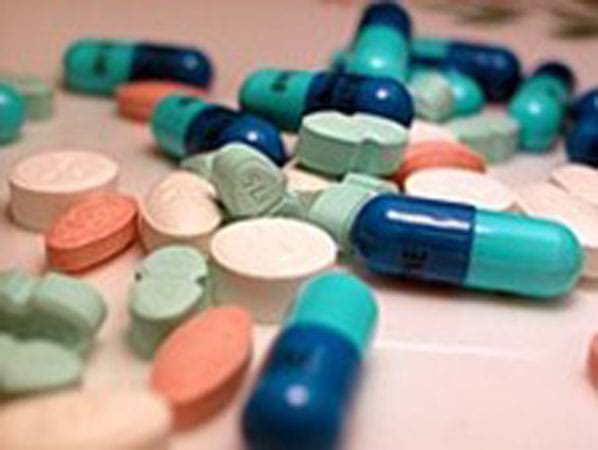
Engineering Connection
Surprisingly, much design goes in to developing pill tablet coatings and the systems that apply these coatings. Varying the material or thickness of a coating can dramatically affect a medication's effect on the body. Engineers play an integral role in this process, from developing and testing chemicals for coatings to designing the complex systems used to mass produce uniformly-coated pills.
Learning Objectives
After this activity, students should be able to:
- Describe how simulation is used to test the human body's reaction to medication.
- Explain how engineers can directly and indirectly help people who are suffering from medical issues, specifically those relating to the digestive system.
- Describe the function of the stomach in the human digestion process.
Educational Standards
Each TeachEngineering lesson or activity is correlated to one or more K-12 science,
technology, engineering or math (STEM) educational standards.
All 100,000+ K-12 STEM standards covered in TeachEngineering are collected, maintained and packaged by the Achievement Standards Network (ASN),
a project of D2L (www.achievementstandards.org).
In the ASN, standards are hierarchically structured: first by source; e.g., by state; within source by type; e.g., science or mathematics;
within type by subtype, then by grade, etc.
Each TeachEngineering lesson or activity is correlated to one or more K-12 science, technology, engineering or math (STEM) educational standards.
All 100,000+ K-12 STEM standards covered in TeachEngineering are collected, maintained and packaged by the Achievement Standards Network (ASN), a project of D2L (www.achievementstandards.org).
In the ASN, standards are hierarchically structured: first by source; e.g., by state; within source by type; e.g., science or mathematics; within type by subtype, then by grade, etc.
NGSS: Next Generation Science Standards - Science
| NGSS Performance Expectation | ||
|---|---|---|
|
MS-ETS1-1. Define the criteria and constraints of a design problem with sufficient precision to ensure a successful solution, taking into account relevant scientific principles and potential impacts on people and the natural environment that may limit possible solutions. (Grades 6 - 8) Do you agree with this alignment? |
||
| Click to view other curriculum aligned to this Performance Expectation | ||
| This activity focuses on the following Three Dimensional Learning aspects of NGSS: | ||
| Science & Engineering Practices | Disciplinary Core Ideas | Crosscutting Concepts |
| Define a design problem that can be solved through the development of an object, tool, process or system and includes multiple criteria and constraints, including scientific knowledge that may limit possible solutions. Alignment agreement: | The more precisely a design task's criteria and constraints can be defined, the more likely it is that the designed solution will be successful. Specification of constraints includes consideration of scientific principles and other relevant knowledge that is likely to limit possible solutions. Alignment agreement: | All human activity draws on natural resources and has both short and long-term consequences, positive as well as negative, for the health of people and the natural environment. Alignment agreement: The uses of technologies and any limitations on their use are driven by individual or societal needs, desires, and values; by the findings of scientific research; and by differences in such factors as climate, natural resources, and economic conditions.Alignment agreement: |
| NGSS Performance Expectation | ||
|---|---|---|
|
MS-ETS1-3. Analyze data from tests to determine similarities and differences among several design solutions to identify the best characteristics of each that can be combined into a new solution to better meet the criteria for success. (Grades 6 - 8) Do you agree with this alignment? |
||
| Click to view other curriculum aligned to this Performance Expectation | ||
| This activity focuses on the following Three Dimensional Learning aspects of NGSS: | ||
| Science & Engineering Practices | Disciplinary Core Ideas | Crosscutting Concepts |
| Analyze and interpret data to determine similarities and differences in findings. Alignment agreement: | There are systematic processes for evaluating solutions with respect to how well they meet the criteria and constraints of a problem. Alignment agreement: Sometimes parts of different solutions can be combined to create a solution that is better than any of its predecessors.Alignment agreement: Although one design may not perform the best across all tests, identifying the characteristics of the design that performed the best in each test can provide useful information for the redesign process—that is, some of the characteristics may be incorporated into the new design.Alignment agreement: | |
| NGSS Performance Expectation | ||
|---|---|---|
|
MS-LS1-3. Use argument supported by evidence for how the body is a system of interacting subsystems composed of groups of cells. (Grades 6 - 8) Do you agree with this alignment? |
||
| Click to view other curriculum aligned to this Performance Expectation | ||
| This activity focuses on the following Three Dimensional Learning aspects of NGSS: | ||
| Science & Engineering Practices | Disciplinary Core Ideas | Crosscutting Concepts |
| Use an oral and written argument supported by evidence to support or refute an explanation or a model for a phenomenon. Alignment agreement: | In multicellular organisms, the body is a system of multiple interacting subsystems. These subsystems are groups of cells that work together to form tissues and organs that are specialized for particular body functions. Alignment agreement: | Systems may interact with other systems; they may have sub-systems and be a part of larger complex systems. Alignment agreement: Scientists and engineers are guided by habits of mind such as intellectual honesty, tolerance of ambiguity, skepticism, and openness to new ideas.Alignment agreement: |
Common Core State Standards - Math
-
Understand the concept of a ratio and use ratio language to describe a ratio relationship between two quantities.
(Grade
6)
More Details
Do you agree with this alignment?
-
Find a percent of a quantity as a rate per 100 (e.g., 30% of a quantity means 30/100 times the quantity); solve problems involving finding the whole, given a part and the percent.
(Grade
6)
More Details
Do you agree with this alignment?
International Technology and Engineering Educators Association - Technology
-
Advances and innovations in medical technologies are used to improve healthcare.
(Grades
6 -
8)
More Details
Do you agree with this alignment?
-
Refine design solutions to address criteria and constraints.
(Grades
6 -
8)
More Details
Do you agree with this alignment?
State Standards
Colorado - Math
-
Express the comparison of two whole number quantities using differences, part-to-part ratios, and part-to-whole ratios in real contexts, including investing and saving.
(Grade
6)
More Details
Do you agree with this alignment?
Colorado - Science
-
Develop and design a scientific investigation about human body systems
(Grade
7)
More Details
Do you agree with this alignment?
-
Gather, analyze, and interpret data and models on the functions and interactions of the human body
(Grade
7)
More Details
Do you agree with this alignment?
Materials List
Each group needs:
- 60 ml (¼ cup) flour
- 30 ml (1/8 cup) cornstarch
- 60 ml (¼ cup) sugar
- 30 ml (1/8 cup) vegetable oil
- 1 paper plate
- 4 small paper or plastic bowls or cups
- 1 clear plastic cup
- 1 cup clear diet (to avoid stickiness) soda
- 1 small plastic spoon
- 2 pieces of color-coated candy per group (Runts or Skittles work well)
- Recipe and Fraction Worksheet, one per person
For the entire class to share:
- marker, to write team names on plastic cups
- 1 cup clear diet soda in a plastic cup (for experiment control)
- timer
Worksheets and Attachments
Visit [www.teachengineering.org/activities/view/cub_biomed_lesson05_activity1] to print or download.Pre-Req Knowledge
A basic knowledge of the parts of the digestive system and how they interact, as provided in the Teacher Background section or in the Intro/Motivation section of the TeachEngineering Digestive System lesson.
Introduction/Motivation
Sarah is a fifth-grade student with an extremely sensitive stomach that is irritated by certain foods and many medications. Sarah recently came down with an illness that caused her to have a high fever, among other symptoms. Her mother wants to help Sarah fight the fever by giving her some aspirin, but she is afraid that the medicine might make Sarah's stomach hurt. Can you think of some ways you might be able to help Sarah? (Possible answers: Have Sarah take the medication with food, use a different type of medication that does not cause stomach pain, use a coated aspirin, drink fluids and take a cooling sponge bath, have Sarah take the aspirin with another type of medication that helps stomach pain, etc.)
Many medicines help our bodies fight sicknesses and diseases, but can also make our stomachs hurt. Can anyone tell me where the stomach is in the digestive system and what it does? (Refer to the Teacher Background information in the TeachEngineering Digestion Simulation lesson.) To prevent this stomach pain while still allowing the medication to get into our bodies, engineers and pharmacists have developed pill coatings that do not dissolve until after they have passed through our stomachs. These specially-coated pills are called "enteric-coated" pills or tablets.
Today, we are going to help Sarah by acting as engineers and developing our own "enteric" coating. We will create a recipe for our coating, and then test it by observing its effectiveness in protecting a piece of candy placed in an environment that simulates the environment found in our stomachs. Before we get started, why is it better to test the pill in a simulated environment rather than testing it on a human? (Possible answers: The coating could fail and make the person's stomach hurt, it is easier to observe how the pill dissolves in the simulated environment, etc.). Then, just like engineers, we will analyze our coating and make suggestions for improvements to our design.
Procedure
Background
A protective coating can serve a variety of functions: Protecting the chemical components in a pill during packaging and handling; protecting the pill from temperature, moisture or light during storage; covering the bad taste of the pill chemicals; smoothing the edges so it is easier to swallow; helping the pill resist digestion to protect certain parts of our digestive system; providing an extended dose of medication; providing a surface for printing; and enhancing the image of the drug for marketing purposes. Engineers design coatings and coating systems to fulfill these functions. For more in-depth background, see the attached Protective Pill Coatings Teacher Background Sheet.
Before the Activity
- Gather materials and measure specified amounts of flour, cornstarch, sugar and vegetable into individual bowls.
- Make enough copies of the Recipe and Fraction Worksheet to provide one per person.
With the Students
- Divide the class into groups of two or three students each.
- Pass out worksheets and materials to each group (see Figure 1).
- Discuss with the class the different properties of each ingredient. Oil helps the dry ingredients stick together, helps make the mixture less sticky, and makes the coating less soluble. Flour and cornstarch are thickening agents with fairly similar properties. They also improve the workability of the overall mixture. Sugar thickens the mixture to some extent and makes the texture grainier, but can also make it less soluble when used in the right proportion, thereby improving its performance as a protective coating.
- Before any mixing is done, have student teams decide amongst themselves how much of each ingredient (in spoonfuls) they think they want in their coatings. These become their recipes, which they document on their worksheets.
- Following their recipes, direct students to begin mixing their coatings on paper plates (see Figure 1). If a team feels that more of a certain ingredient is called for, have them carefully measure it and add it into the mixture, remembering to make the changes to the recipe on their worksheets.
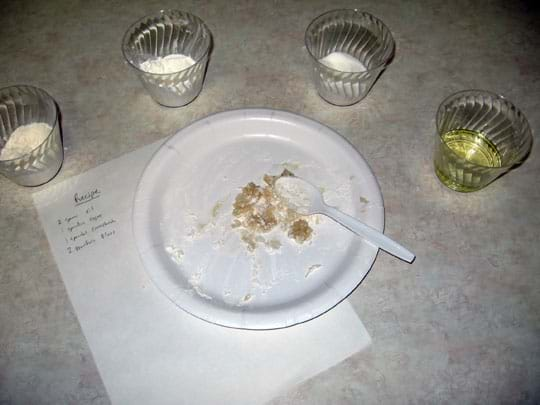
- When a group has finished creating their coating mixture and recipe, have them apply the coating to a piece of candy (see Figure 2). Encourage students to make a thin and sleek design so the pill is easy to swallow, inexpensive to ship, and requires less packaging.
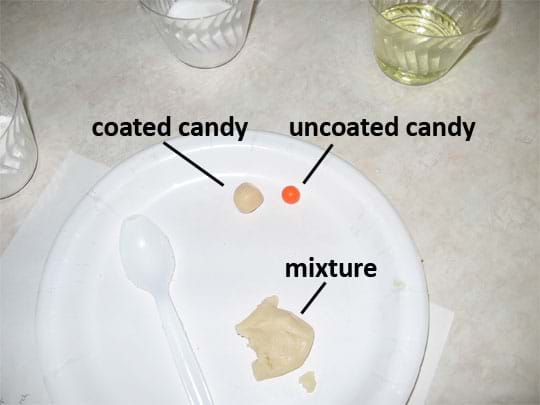
- When all of the groups are finished, have a representative from each bring their coated candy to the front of the class. For each team, fill a plastic glass half full with clear soda, plus one extra cup of clear soda for an uncoated piece of candy (so students can see their coatings' effect on the dissolving rate of the candy). Label the cups with a marker so each group's cup can be easily identified.
- With the timer ready, and at the same time, have students drop their coated candies into their cups of clear soda, while the teacher drops an uncoated candy into its cup of clear soda as a control (see Figure 3).
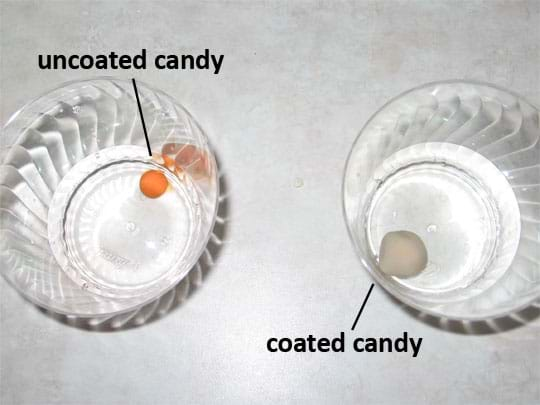
- Allow the candy to sit in the soda for 10 minutes (see Figure 4). After several minutes, if the coatings do not look like they are dissolving, have one student from each group stir their coated candy in its soda cup until the 10 minutes is over. Ask students: How does this step simulates a pill going through the human digestive tract? (Answer: This simulates the acidic environment of the stomach, as well as its churning and agitating movement.) Why is it better to test the pill in a simulated environment rather than testing it on a human? (Possible answers: The coating could fail and make the person's stomach hurt, it is easier to observe how the pill dissolves in the simulated environment, etc.).
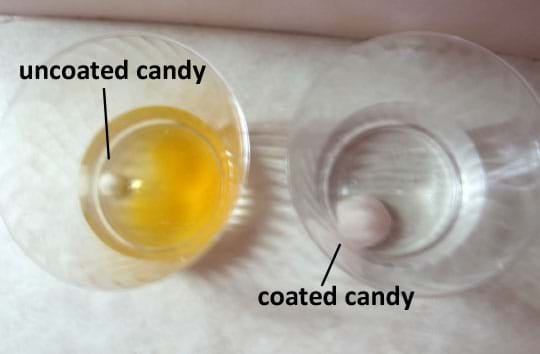
- While waiting, keep students busy with another class activity or by having them draw ads that describe the benefits of their pill coatings.
- After 10 minutes have passed, have students remove their pieces of coated candy from the soda-filled cups (see Figure 5). As a class, make observations about which coating did the best job of protecting the candy "pill" and compare the coating recipes for each group to see what did and did not work. How did the coatings perform, compared to the uncoated control "pill," and compared to the various team recipes?
- Have students calculate on their worksheets the fractions represented by each ingredient in their recipes. Compare recipes among teams, and discuss as a class, as described in the Assessment section. What are the relationships between performance and proportion of certain ingredients? What are the advantages and disadvantages of using certain materials?
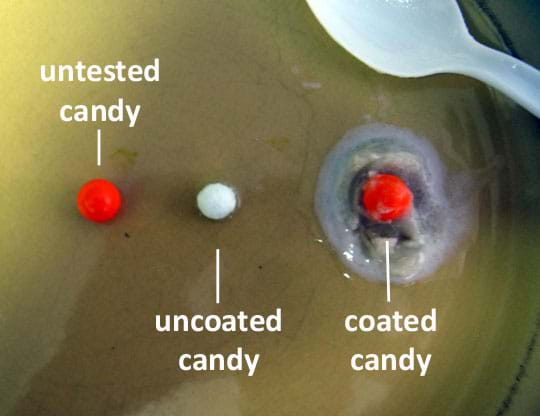
- Using what they learned from analyzing the testing results and original recipes, direct each group to write down a new and improved coating recipe.
- Following their new recipes, have each team mix up a new coating batch. Do not allow them to make changes to their recipes during this stage.
- Repeat the same procedure for coating and testing, and then compare the results again as a class. What improvements were made?
- Conclude by reflecting on the activity in terms of the universal steps of the engineering design process: Ask, Imagine, Plan, Create and Improve, as described in the Assessment section. These are the steps engineers go through in designing new products and processes.
Vocabulary/Definitions
bioengineering: The use of artificial tissues, organs or organ components to replace damaged or absent parts of the body, such as artificial limbs and heart pacemakers. Source: The Oxford Pocket Dictionary of Current English, http://encyclopedia.com/doc/1O999-bioengineering.html
biomedical engineer: A person who blends traditional engineering techniques with the biological sciences and medicine to improve the quality of human health and life. Biomedical engineers design artificial body parts, medical devices, diagnostic tools, and medical treatment methods.
engineer: A person who applies his/her understanding of science and math to creating things for the benefit of humanity and our world.
enteric: Of or pertaining to the enteron (the digestive tract or intestines). A medicinal preparation treated to pass through the stomach unaltered and disintegrate in the intestines.
simulation: Imitating the behavior of some situation or process, especially for the purpose of study or experimental testing.
soluble: Capable of being dissolved or liquefied.
Assessment
Pre-Activity Assessment
Class Discussion: Have students contribute to a class discussion about which foods or medications make their stomachs hurt (Possible answers: Spicy foods, soft drinks, milk, pain medications such as aspirin, Advil or Aleve). Discuss possible solutions to these problems. (Possible answers: Taking pills with food, taking enteric-coated rather than uncoated pills, stomach medications, avoiding certain types of foods, etc.)
Activity Embedded Assessment
Recipe Analysis: Have students calculate on their Recipe and Fraction Worksheets the fraction of the entire coating represented by each individual ingredient. Have teams compare their recipe breakdowns to other groups, looking for relationships between performance and the proportion of certain materials in the recipe. Discuss with the students possible drawbacks or advantages to using a higher proportion of certain ingredients, aside from the coating's performance during the test phase. (Possible answers: A high proportion of sugar makes the pill taste better and easier to swallow, a high proportion of flour or cornstarch makes the coating more workable and allows for a thinner application, which decreases packaging and shipping costs, etc.). Ask students to describe the balance that we are trying to achieve with all these variables. (Answer: We're trying "protect the pill," but also get the most other advantages and the fewest other disadvantages.)
Post-Activity Assessment
Class Discussion/Design Process: As a class, list all of the steps in the engineering design process: Ask, Imagine, Plan, Create, Improve. Use the engineering design process graphic as an overhead transparency or slide to show the class.
As a class, discuss what goes on during each step of the process and relate each step to some part of the activity just performed. (Example: Ask – in this step, we talked about a problem and asked everyone how stomach pain has been treated in the past; Imagine – in this step, we brainstormed ideas for helping Sarah with her stomach pain, chose to make a pill coating, and decided which materials to use in the coating; Plan – in this step, we wrote out a recipe for the coating mixture; Create – in this step, we mixed the ingredients in the planned proportions, made adjustments, and tested the coating; Improve – in this step, we analyzed the recipe based on its performance during testing and compared to other groups' recipes, created an improved recipe, mixed the ingredients together, and tested the new coating.)
Safety Issues
The activity materials have the potential to be extremely messy, so emphasize cleanliness and keep cleaning materials nearby. Consider laying down newspaper on and around the desks as protection from spills.
Troubleshooting Tips
To make very sticky concoctions more workable, add extra flour or cornstarch.
To prevent students from making a super-thick coating, set a limit on the maximum thickness permitted. Constraints like this are typical in real-world engineering design projects.
Activity Extensions
Have students research the different materials used as pill coatings and the different mechanical systems used to coat pills.
Redo the experiment and challenge the students to design their coatings based on taste, marketability, cost and ease of shipping and handling while still meeting a certain benchmark protection time (such as 10 minutes, 15 minutes, etc.) during the test phase.
Activity Scaling
- For lower grades, eliminate one or two of the dry ingredients to make the recipes simpler.
- For upper grades, add additional ingredients such as salt, corn syrup or water to make the recipes more complex. Lead a discussion to explore why certain items were better pill coating ingredients than others and try to determine what function each ingredient served.
- For upper grades, turn this activity into a competition by challenging each group to make their pill dissolve at a specified time (that is, not too early and not too late).
Additional Multimedia Support
See a photograph of shellac excretions at the Spectroscopy NOW website: http://www.docstoc.com/docs/100688383/Protective-Pill-Coatings
See a photograph of unprocessed shellac at the Lexportex (India) Pvt. Ltd. website: http://www.indianshellac.com/pics/pic2.jpg
See a photograph of a supercell tablet coater at the GEA Process Engineering Inc. website: http://www.niroinc.com/images/pharma_systems/supercell_tablet_coater.jpg
See a useful engineering design process graphic at the Museum of Boston's Engineering is Elementary website.
Subscribe
Get the inside scoop on all things TeachEngineering such as new site features, curriculum updates, video releases, and more by signing up for our newsletter!More Curriculum Like This

To reinforce students' understanding of the human digestion process, the functions of several stomach and small intestine fluids are analyzed, and the concept of simulation is introduced through a short, introductory demonstration of how these fluids work. Students learn what simulation means and ho...

Students are challenged to think as biomedical engineers and brainstorm ways to administer medication to a patient who is unable to swallow. They learn about the advantages and disadvantages of current drug delivery methods—oral, injection, topical, inhalation and suppository—and pharmaceutical desi...

This lesson introduces students to the main parts of the digestive system and how they interact. In addition, students learn about some of the challenges astronauts face when eating in outer space. Engineers figure out how to deal with such challenges.

Students are introduced to a challenge question. Towards answering the question, they generate ideas for what they need to know about medicines and how they move through our bodies, watch a few short videos to gain multiple perspectives, and then learn lecture material to obtain a basic understandin...
References
Dictionary.com. Lexico Publishing Group, LLC. Accessed December 30, 2008. (Source of some vocabulary definitions, with some modifications) http://www.dictionary.com
Pharmaceutical Glaze. Last updated May 11, 2008. Wikipedia Free Online Encyclopedia. Accessed July 7, 2008. http://en.wikipedia.org/wiki/Pharmaceutical_glaze
Tablet. Last updated July 5, 2008. Wikipedia Free Online Encyclopedia. Accessed July 7, 2008. http://en.wikipedia.org/wiki/Tablet
The Tablet Coating Process Design and Control. Last updated January 2008. Invensys, Eurotherm Life Sciences Solutions. Accessed December 30, 2008. http://www.eurotherm.com/industries/life-sciences/applications/tablet-coating/
Copyright
© 2008 by Regents of the University of ColoradoContributors
Jacob Crosby; Todd Curtis; Malinda Schaefer Zarske; Denise W. CarlsonSupporting Program
Integrated Teaching and Learning Program, College of Engineering, University of Colorado BoulderAcknowledgements
The contents of this digital library curriculum were developed under grants from the Fund for the Improvement of Postsecondary Education (FIPSE), U.S. Department of Education and National Science Foundation (GK-12 grant no. 0338326). However, these contents do not necessarily represent the policies of the Department of Education or National Science Foundation, and you should not assume endorsement by the federal government.
Last modified: February 13, 2020










User Comments & Tips